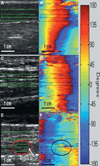Ultrasound elastography: the new frontier in direct measurement of muscle stiffness
- PMID: 25064780
- PMCID: PMC4254343
- DOI: 10.1016/j.apmr.2014.07.007
Ultrasound elastography: the new frontier in direct measurement of muscle stiffness
Abstract
The use of brightness-mode ultrasound and Doppler ultrasound in physical medicine and rehabilitation has increased dramatically. The continuing evolution of ultrasound technology has also produced ultrasound elastography, a cutting-edge technology that can directly measure the mechanical properties of tissue, including muscle stiffness. Its real-time and direct measurements of muscle stiffness can aid the diagnosis and rehabilitation of acute musculoskeletal injuries and chronic myofascial pain. It can also help monitor outcomes of interventions affecting muscle in neuromuscular and musculoskeletal diseases, and it can better inform the functional prognosis. This technology has implications for even broader use of ultrasound in physical medicine and rehabilitation practice, but more knowledge about its uses and limitations is essential to its appropriate clinical implementation. In this review, we describe different ultrasound elastography techniques for studying muscle stiffness, including strain elastography, acoustic radiation force impulse imaging, and shear-wave elastography. We discuss the basic principles of these techniques, including the strengths and limitations of their measurement capabilities. We review the current muscle research, discuss physiatric clinical applications of these techniques, and note directions for future research.
Keywords: Diagnostic imaging; Elasticity; Hardness; Muscles; Rehabilitation; Ultrasonography.
Copyright © 2014 American Congress of Rehabilitation Medicine. Published by Elsevier Inc. All rights reserved.
Figures




References
-
- Basford JR, Jenkyn TR, An KN, Ehman RL, Heers G, Kaufman KR. Evaluation of healthy and diseased muscle with magnetic resonance elastography. Arch Phys Med Rehabil. 2002 Nov;83(11):1530–1536. - PubMed
-
- Chen Q, Bensamoun S, Basford JR, Thompson JM, An KN. Identification and quantification of myofascial taut bands with magnetic resonance elastography. Arch Phys Med Rehabil. 2007 Dec;88(12):1658–1661. - PubMed
-
- Debernard L, Robert L, Charleux F, Bensamoun SF. Analysis of thigh muscle stiffness from childhood to adulthood using magnetic resonance elastography (MRE) technique. Clin Biomech (Bristol, Avon) 2011 Oct;26(8):836–840. Epub 2011 May 14. - PubMed
-
- Ophir J, Cespedes I, Ponnekanti H, Yazdi Y, Li X. Elastography: a quantitative method for imaging the elasticity of biological tissues. Ultrason Imaging. 1991 Apr;13(2):111–134. - PubMed
Publication types
MeSH terms
Grants and funding
LinkOut - more resources
Full Text Sources
Other Literature Sources
Medical

